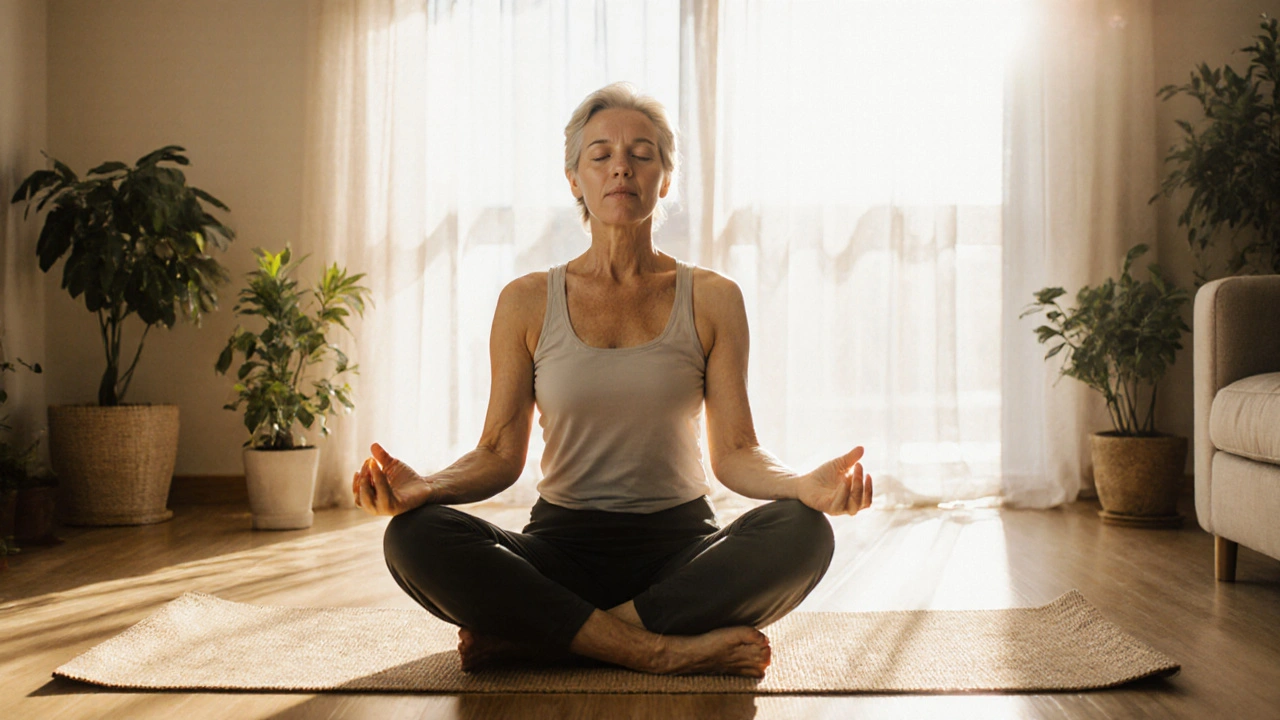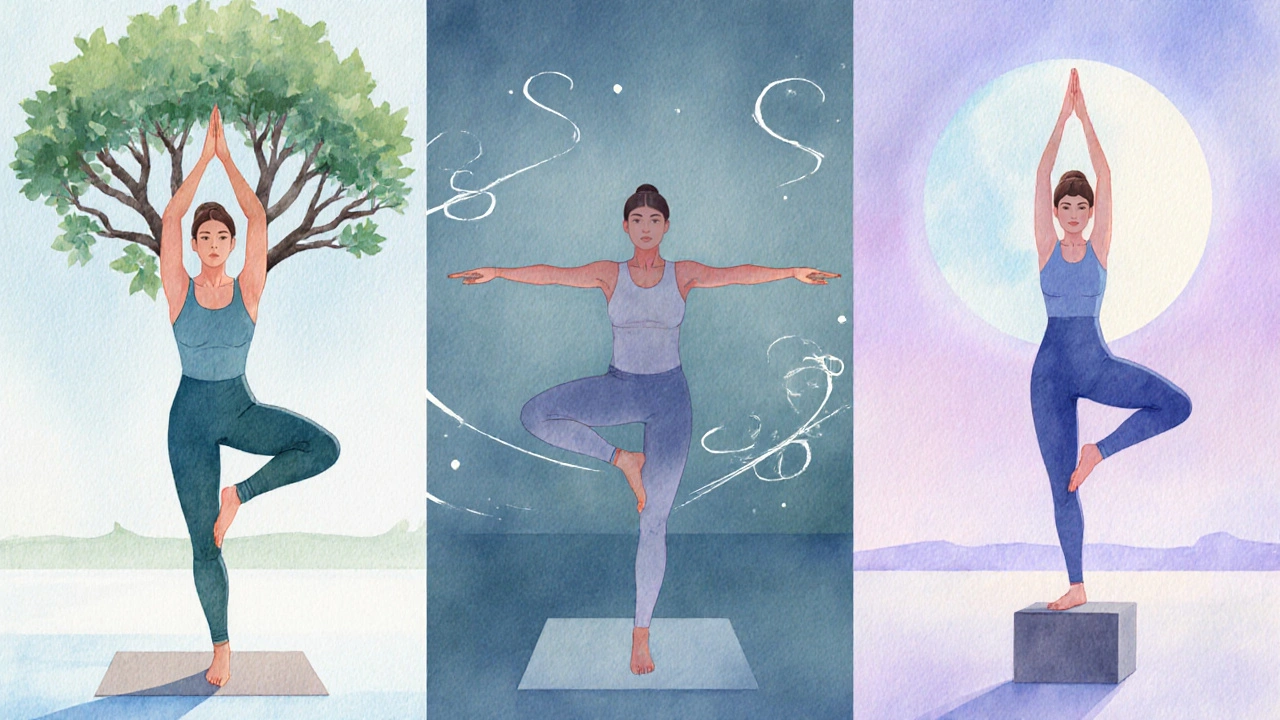Menopause and Yoga: Best Poses for Balance and Relaxation

Menopause Symptom Reduction Calculator
Symptom Improvement Estimator
Estimate potential reduction in hot flashes and sleep issues based on your yoga practice consistency. Based on University of Sydney research (2023) showing 30% symptom reduction with regular practice.
Estimated Results
Hot Flashes
Projected reduction after 8 weeks of consistent practice
Sleep Quality
Projected improvement in sleep disturbances
Key Takeaways
- Gentle yoga poses can ease hot flashes, improve sleep, and boost mood during menopause.
- Balance‑focused asanas like Tree Pose protect bone health and prevent falls.
- Relaxation‑oriented poses such as Child's Pose and Legs‑Up‑The‑Wall calm the nervous system.
- Consistent practice-15‑20 minutes a day-delivers measurable benefits in just a few weeks.
- Adapt the routine to your energy level; yoga is a flexible tool, not a rigid regimen.
When hormonal shifts turn your body into a roller‑coaster, menopause yoga offers a steadying hand. Yoga for Menopause is a tailored practice that blends balance, breath, and gentle stretching to address the specific challenges of menopause. The goal isn’t to become a contortionist; it’s to create a routine that eases hot flashes, steadies mood swings, and supports the bones that can become fragile after estrogen drops.
Why Yoga Works for Menopause
During menopause, the body experiences lower estrogen, higher cortisol, and fluctuating progesterone. These changes affect:
- Thermoregulation - leading to hot flashes and night sweats.
- Bone density - increasing osteoporosis risk.
- Mood and sleep - spikes in anxiety, irritability, and insomnia.
- Muscle mass - gradual loss of strength and balance.
Yoga tackles each of these issues through three core mechanisms:
- Movement: Low‑impact poses stimulate circulation, encouraging the body to regulate temperature more efficiently.
- Breath: Pranayama (controlled breathing) reduces cortisol, calming the stress response.
- Mindfulness: Staying present lowers the emotional impact of mood swings.
Research from the University of Sydney (2023) showed that women who practiced yoga twice a week for eight weeks reported a 30% reduction in night‑time sweating and improved sleep quality by an average of 1.5hours.

Essential Poses for Balance
Balance poses strengthen the stabilizing muscles around the hips and knees, crucial for preventing falls as bone density changes. Below are the top three asanas that are both safe and effective.
- Tree Pose (Vrikshasana) a standing balance that engages the core, thighs, and ankle stabilizers. Hold for 30seconds each side, gradually increasing to 1minute.
- Warrior II (VirabhadrasanaII) builds leg strength and trains the brain to maintain alignment under strain. Keep the front knee bent, back leg straight, and gaze over the front hand for 45seconds.
- Half Moon Pose (Ardha Chandrasana) improves proprioception by challenging one‑leg support while opening the hips. Use a block for support until confidence grows.
Poses that Promote Deep Relaxation
When hot flashes flare up, calming the nervous system is key. The following poses incorporate gentle forward folds and inversion (feet‑up‑the‑wall) to activate the parasympathetic response.
- Child’s Pose (Balasana) a restorative forward fold that lowers heart rate and releases tension in the back. Stay for 2-3minutes, breathing deep into the belly.
- Cat‑Cow (Marjaryasana‑Bitilasana) a spinal articulation that balances heat and coolness through coordinated breath. Perform 10 cycles, matching inhale to arch and exhale to round.
- Legs‑Up‑The‑Wall (Viparita Karani) a mild inversion that drains excess blood from the pelvis, reducing swelling and calming anxiety. Hold for 5-10minutes, optionally placing a pillow under the lower back.
Putting It All Together: A 20‑Minute Daily Routine
Consistency beats intensity for menopause support. Here’s a simple sequence you can flow through in about 20minutes-perfect for a morning wake‑up or an evening wind‑down.
- 5minutes of gentle breathing: seated or lying, inhale for 4 counts, exhale for 6.
- Warm‑up Cat‑Cow - 10 rounds.
- Balance block - Tree Pose (30seconds each side) → WarriorII (45seconds each side) → Half Moon (30seconds each side).
- Hip and hamstring release - Forward Fold (1minute) → Child’s Pose (2minutes).
- Inversion cooldown - Legs‑Up‑The‑Wall (5minutes). Finish with a few minutes of gratitude meditation.
Adjust the timing based on how you feel. If a hot flash strikes, pause in Child’s Pose, focus on the breath, and resume when you’re calmer.

Tips to Maximize Benefits and Avoid Common Pitfalls
- Stay hydrated. Hormonal shifts can make you feel dehydrated; water supports temperature regulation.
- Wear breathable fabrics. Loose cotton or moisture‑wicking yoga gear helps keep the body cool.
- Listen to your body. If a pose feels shaky, use a wall or a chair for support-better safe than strained.
- Combine with strength training. Two 20‑minute yoga sessions a week plus two short resistance workouts protect bone health.
- Track progress. Keep a simple journal: note sleep hours, flash frequency, and mood before and after each week of practice.
Sample Weekly Schedule
Below is a practical layout for a busy woman in her fifties. Feel free to shuffle days to fit work or family commitments.
| Day | Activity | Duration | Focus |
|---|---|---|---|
| Monday | Yoga Balance Sequence | 20min | Stability & bone health |
| Tuesday | Light resistance (bands) | 15min | Muscle strength |
| Wednesday | Relaxation Flow | 20min | Stress reduction |
| Thursday | Restorative Yoga (Legs‑Up‑The‑Wall) | 15min | Sleep quality |
| Friday | Combined Yoga + Walking | 30min | Cardiovascular health |
| Saturday | Gentle Stretch & Breath | 20min | Mindfulness |
| Sunday | Rest day or optional meditation | 5‑10min | Recovery |
Frequently Asked Questions
Can I start yoga if I’ve never exercised before?
Absolutely. Begin with the gentle poses listed above, use props like blocks or chairs, and aim for consistency over intensity. Many community centers offer beginner‑friendly menopause yoga classes.
Is it safe to do inversions like Legs‑Up‑The‑Wall if I have high blood pressure?
Legs‑Up‑The‑Wall is a mild inversion that typically doesn’t raise blood pressure. If you have severe hypertension or heart concerns, check with your doctor first, but most women find it soothing and safe.
How often should I practice to notice a reduction in hot flashes?
Studies suggest twice‑a‑week sessions of 20‑30minutes can produce noticeable changes within 4-6weeks. Consistency beats occasional marathon sessions.
Do I need any special equipment?
A yoga mat, a sturdy block or folded blanket, and comfortable clothing are enough. Optional props-strap, bolster-can help deeper stretches.
Can yoga replace hormone replacement therapy (HRT)?
Yoga complements HRT but isn’t a replacement. It can lower the need for medication by easing symptoms, yet any hormonal decisions should be made with a healthcare professional.

Noah Bentley
October 14, 2025 AT 21:55Wow, another yoga guide, because we all needed more spreadsheets of poses.
Ogah John
October 17, 2025 AT 05:29Reading through the routine feels like a meditation on the futility of over‑planning-yet the gentle reminders to breathe actually ground the chaos. If you can turn a hot flash into a mindful pause, you’re already winning.
Kelvin Murigi
October 19, 2025 AT 13:02Yoga isn’t a miracle cure, but it builds a physiological buffer against the hormonal roller‑coaster of menopause.
Regular practice activates the parasympathetic nervous system, which in turn lowers cortisol levels that otherwise amplify night sweats.
The balance poses you listed-Tree, Warrior II, Half‑Moon-target the stabilizing muscles around the hips and knees, crucial for maintaining bone density when estrogen wanes.
By holding Tree Pose for thirty seconds on each side, you engage the gluteus medius, a key player in lateral hip stability that guards against falls.
Warrior II adds a dynamic stretch to the hip flexors while strengthening the quadriceps, giving the legs a solid foundation for everyday tasks like climbing stairs.
Half‑Moon, especially when supported by a block, challenges proprioception, teaching the brain to trust subtle shifts in weight distribution.
The relaxation sequence-Child’s Pose, Cat‑Cow, Legs‑Up‑The‑Wall-creates a gentle inversion that redirects blood away from the pelvic region, reducing the feeling of internal heat.
In Legs‑Up‑The‑Wall, the venous return improves, which can lower peripheral edema that some women experience during menopause.
Breath work, even the simple 4‑6 inhalation/exhalation pattern, lengthens the exhalation phase, a proven method for dampening the sympathetic surge that triggers hot flashes.
Studies from the University of Sydney, as you cited, demonstrate a roughly 30 % reduction in night sweats after eight weeks of consistent practice, confirming the synergy of movement and breath.
Consistency is indeed the key; a modest 15‑20‑minute session five days a week outperforms sporadic hour‑long marathons because it trains the nervous system to adapt.
Pairing yoga with light resistance work-band pulls, body‑weight squats-further stimulates osteoblast activity, helping to preserve bone mineral density.
Hydration, as you mentioned, amplifies these benefits; adequate water intake supports thermoregulation and prevents the body from over‑reacting to temperature fluctuations.
Finally, tracking progress in a simple journal creates a feedback loop that reinforces adherence; note sleep hours, flash frequency, and mood before and after each session.
In sum, think of yoga as a low‑impact, high‑return investment in both physical resilience and mental calm during this transitional life stage.
ahmad matt
October 21, 2025 AT 20:35Honestly, this “balance” list feels like a marketing checklist-throw in a tree pose, sprinkle a wellness tip, and call it science.
kristine ayroso
October 24, 2025 AT 04:09Yo, this is exactly what my sister needed! 🌟 I’m telling her to roll out her mat tonight and binge on those 20‑minute flows-no excuses, just breathe and vibe.
Hayden Kuhtze
October 26, 2025 AT 11:42One might argue that the elegance of Vrikshasana transcends rudimentary checkboxes, but for the sake of the uninitiated, a bullet‑point overview does the heavy lifting.
Craig Hoffman
October 28, 2025 AT 19:15Got a tiny studio? No problem-just fold a blanket for a block and you’re set for Tree Pose without crushing the furniture.
Kenny ANTOINE-EDOUARD
October 31, 2025 AT 02:49Kelvin’s deep dive is spot‑on; I’d add that listening to calming playlists during the relaxation phase can amplify the parasympathetic response, making the post‑yoga wind‑down even smoother.
Sinead McArdle
November 2, 2025 AT 10:22I appreciate the thoroughness; the blend of balance and relaxation seems thoughtfully calibrated for menopausal needs.
Katherine Krucker Merkle
November 4, 2025 AT 17:55Great guide! I’ve started the 20‑minute routine before bed, and my sleep has become noticeably steadier-definitely worth the consistency.
Mark Quintana
November 7, 2025 AT 01:29i think the leg up the wall thing really helps with hot flashes its like a quick chill button.
Brandon Cassidy
November 9, 2025 AT 09:02Exactly, a few minutes of Legs‑Up‑The‑Wall can feel like pressing the reset button on that sudden heat surge.
Halle Redick
November 11, 2025 AT 16:35Let’s spread the word-menopause doesn’t have to mean losing balance, it’s an invitation to find a new steady groove on the mat.
Max Canning
November 14, 2025 AT 00:09All right folks, fire up those mats, set a timer for 20 minutes, and smash that routine-your future self will thank you for the extra bone‑boosting vibes!
Nick Rogers
November 16, 2025 AT 07:42In conclusion; the proposed sequence; when practiced regularly; offers measurable benefits; for both physiological and psychological markers.
Tesia Hardy
November 18, 2025 AT 15:15Don’t worry if you miss a day-just hop back on tomorrow, keep that positive mindset, and the progress will keep comin’.